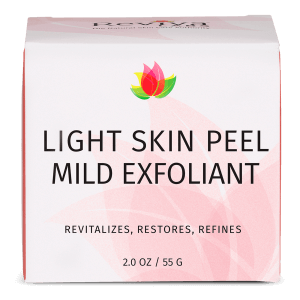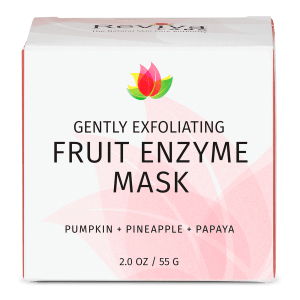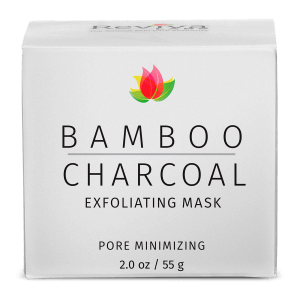Natural, Reviva Labs, Skin Care
A Guide to Chemical Exfoliants
Exfoliation is a crucial step in any skincare routine, helping to remove dead skin cells and reveal a brighter, smoother complexion. While physical exfoliants, such as scrubs, were once the go-to option, chemical exfoliants have become increasingly popular. Chemical exfoliants use acids or enzymes to dissolve the bonds holding dead skin cells together, offering a gentler yet effective method for exfoliation. Understanding the different types of chemical exfoliants and their benefits can help you choose the right one for your skin type and concerns.
Types of Chemical Exfoliants
Chemical exfoliants are generally categorized into three main types: Alpha Hydroxy Acids (AHAs), Beta Hydroxy Acids (BHAs), and Poly Hydroxy Acids (PHAs). Each type has unique properties that cater to different skin concerns and types.
Alpha Hydroxy Acids (AHAs) are water-soluble acids derived from fruits and milk. They work primarily on the surface of the skin, making them ideal for dry and sun-damaged skin. Common AHAs include glycolic acid, lactic acid, and citric acid. Glycolic acid, derived from sugar cane, is known for its small molecular size, allowing it to penetrate the skin effectively. Lactic acid, sourced from milk, is gentler and more suitable for sensitive skin. These acids help to improve skin texture, reduce the appearance of fine lines, and promote an even skin tone.
Beta Hydroxy Acids (BHAs) are oil-soluble acids, making them perfect for oily and acne-prone skin. The most well-known BHA is salicylic acid, derived from willow bark. Salicylic acid penetrates deep into the pores, dissolving excess sebum and dead skin cells, which helps to prevent acne and blackheads. BHAs also have anti-inflammatory properties, making them suitable for sensitive and redness-prone skin.
Poly Hydroxy Acids (PHAs) are a newer generation of exfoliants. They work similarly to AHAs but have a larger molecular structure, which means they penetrate the skin more slowly and are less likely to cause irritation. Common PHAs include gluconolactone and lactobionic acid. PHAs are suitable for all skin types, including sensitive skin, and provide additional hydration benefits while gently exfoliating the skin.
Benefits of Chemical Exfoliation
Incorporating chemical exfoliants into your skincare routine can offer numerous benefits. Regular use of these exfoliants helps to promote cell turnover, leading to a brighter and more radiant complexion. By removing dead skin cells, chemical exfoliants can enhance the absorption of other skincare products, making them more effective.
Chemical exfoliants can also help to address specific skin concerns. For instance, AHAs are effective at reducing the appearance of fine lines and wrinkles, while BHAs are beneficial for managing acne and controlling excess oil. PHAs, with their gentle exfoliating action, are ideal for those with sensitive skin who still want the benefits of chemical exfoliation.
Moreover, chemical exfoliants can improve skin texture and tone. They can help to fade hyperpigmentation and dark spots, resulting in a more even complexion. According to a study published in the Journal of the American Academy of Dermatology, glycolic acid was found to significantly improve skin texture and reduce hyperpigmentation with regular use.
Choosing the Right Chemical Exfoliant
Selecting the right chemical exfoliant for your skin type and concerns is essential for achieving the best results. For those with dry or mature skin, AHAs like glycolic or lactic acid are excellent choices. They provide effective exfoliation while also offering hydrating benefits. However, it’s crucial to start with lower concentrations to avoid potential irritation and gradually increase as your skin builds tolerance.
If you have oily or acne-prone skin, BHAs are the way to go. Salicylic acid is particularly effective in penetrating the pores and reducing breakouts. It’s often found in cleansers, toners, and spot treatments. For sensitive skin, PHAs offer a gentler alternative. They exfoliate the skin without causing significant irritation and provide added moisture, making them suitable for dry and sensitive skin types.
It’s also important to consider the concentration of the active ingredient in the product. Higher concentrations can offer more dramatic results but may also increase the risk of irritation. Starting with a lower concentration and gradually building up is a safer approach, especially if you have sensitive skin.
Incorporating Chemical Exfoliants into Your Routine
Integrating chemical exfoliants into your skincare routine requires careful consideration to avoid over-exfoliation and potential irritation. It’s best to start with exfoliating once or twice a week and gradually increase the frequency as your skin adapts. Listen to your skin and adjust the usage accordingly. If you notice any signs of irritation, such as redness or excessive dryness, reduce the frequency or switch to a gentler formula.
Chemical exfoliants can be found in various forms, including cleansers, toners, serums, and masks. Each form has its benefits, and the choice depends on your preferences and skincare goals. For instance, exfoliating cleansers are a convenient option for those who want a quick and easy addition to their routine. Toners can provide an extra layer of exfoliation and help to balance the skin’s pH. Serums and masks, on the other hand, offer a more concentrated treatment and can be used less frequently.
When using chemical exfoliants, it’s essential to apply sunscreen daily. Exfoliating acids can increase your skin’s sensitivity to the sun, making it more prone to sunburn and damage. A broad-spectrum sunscreen with an SPF of 30 or higher is recommended to protect your skin and maintain the benefits of exfoliation.
Potential Side Effects and Precautions
While chemical exfoliants can provide numerous benefits, it’s essential to be aware of potential side effects and take necessary precautions. Over-exfoliation is a common issue that can lead to skin irritation, redness, and dryness. It’s important to start slowly and gradually increase the frequency of use, allowing your skin to build tolerance.
If you have sensitive skin or are new to chemical exfoliants, consider performing a patch test before incorporating a new product into your routine. Apply a small amount of the product to a discreet area of your skin and monitor for any adverse reactions over 24 hours. This can help you determine if the product is suitable for your skin without risking a full-face application.
Some individuals may experience purging when starting a new chemical exfoliant. Purging occurs when the exfoliant accelerates the turnover of dead skin cells, bringing underlying impurities to the surface. This can result in temporary breakouts, which usually subside within a few weeks as your skin adjusts to the new product.
If you are using other active ingredients in your skincare routine, such as retinoids or vitamin C, be mindful of potential interactions. Combining multiple active ingredients can increase the risk of irritation. It may be beneficial to use these products on alternate days or consult with a dermatologist for personalized advice.
Conclusion
Chemical exfoliants are a powerful tool in achieving smoother, brighter, and more radiant skin. By understanding the different types of chemical exfoliants and their benefits, you can make informed decisions about which products to incorporate into your skincare routine. Whether you choose AHAs, BHAs, or PHAs, it’s essential to start slowly, listen to your skin, and adjust your routine as needed. With consistent use and proper precautions, chemical exfoliants can transform your complexion and help you achieve your skincare goals.
Remember, everyone’s skin is unique, and what works for one person may not work for another. Patience and consistency are key when incorporating new products into your routine. Always prioritize the health and well-being of your skin and consult with a dermatologist if you have any concerns or specific skin conditions. Happy exfoliating!









